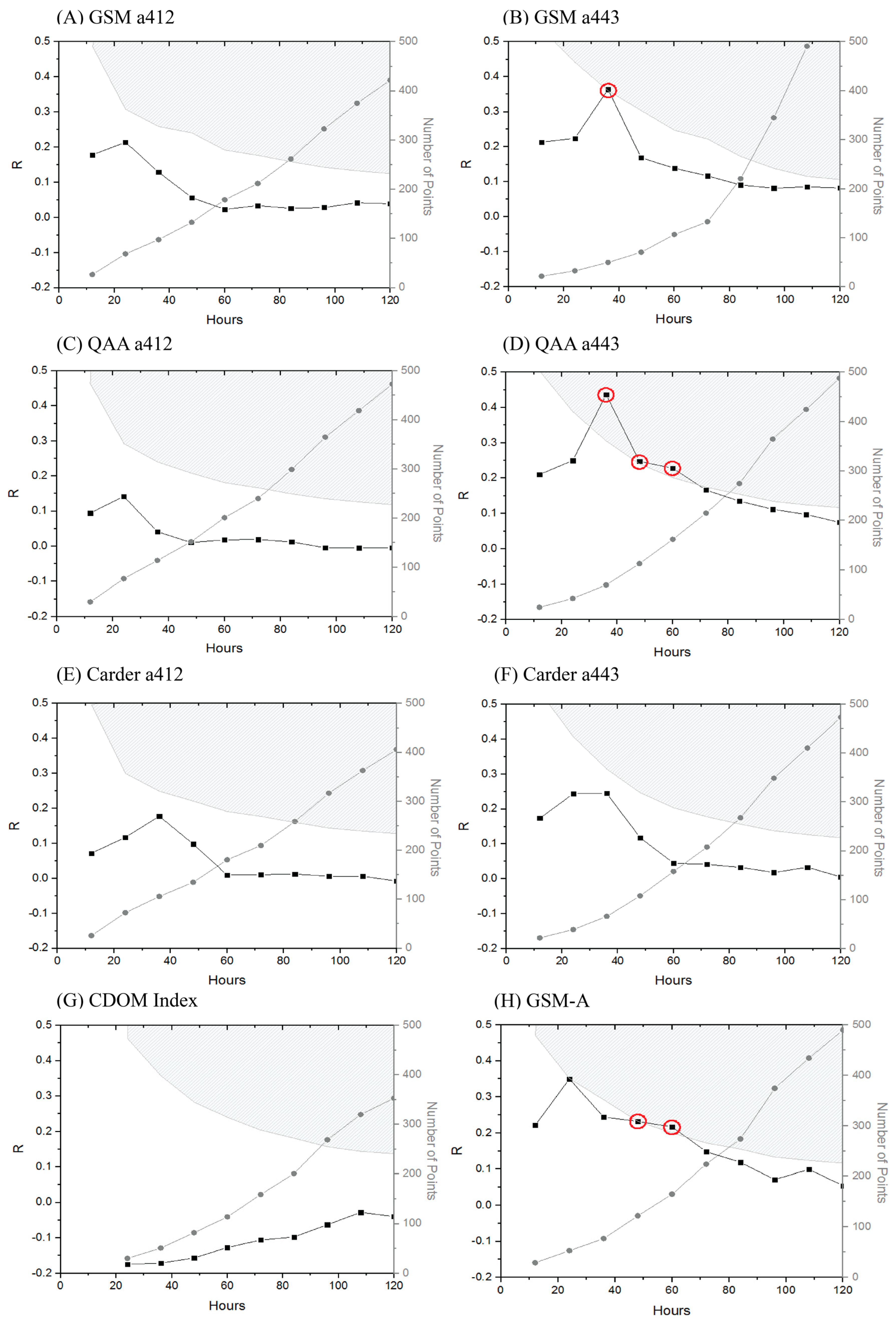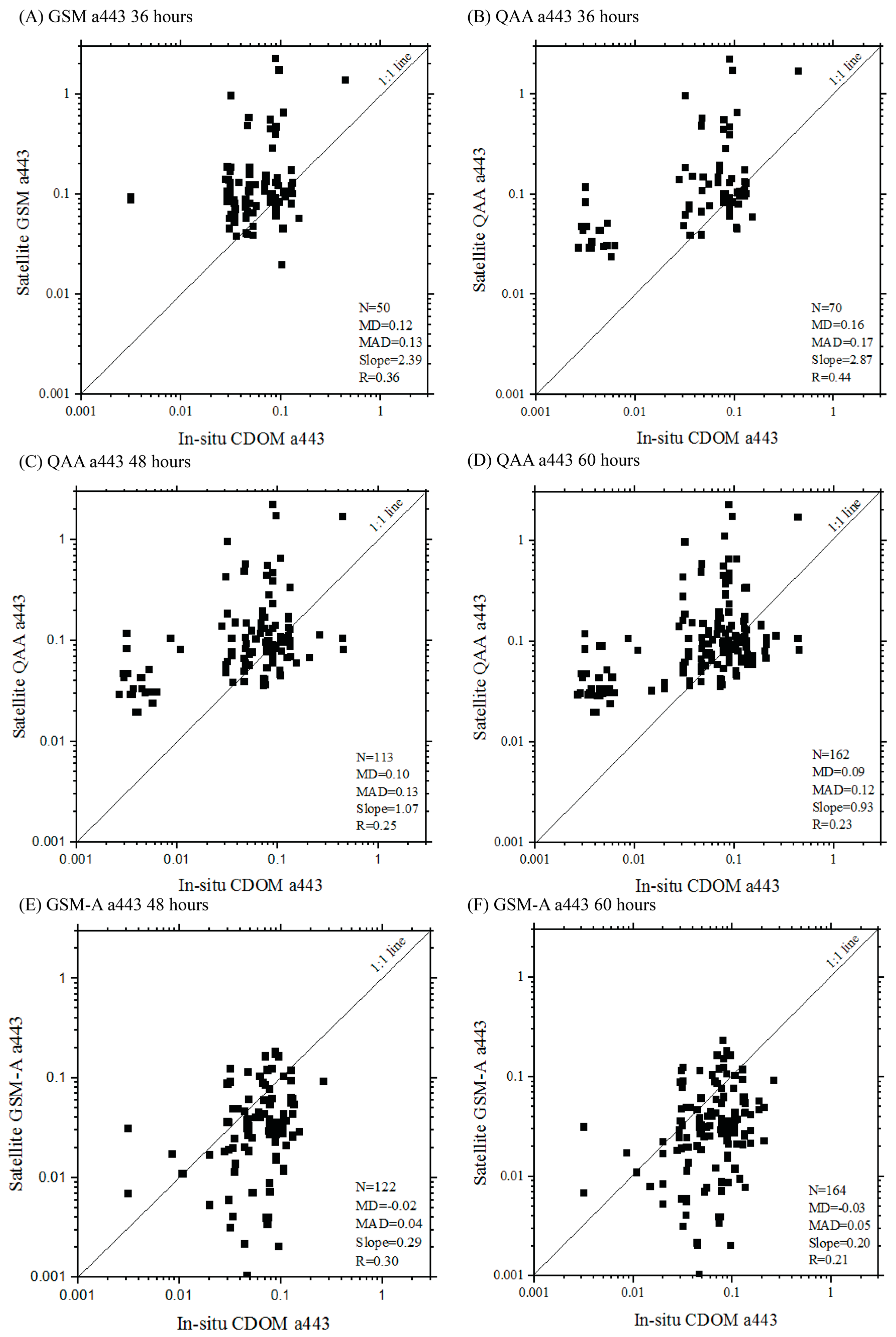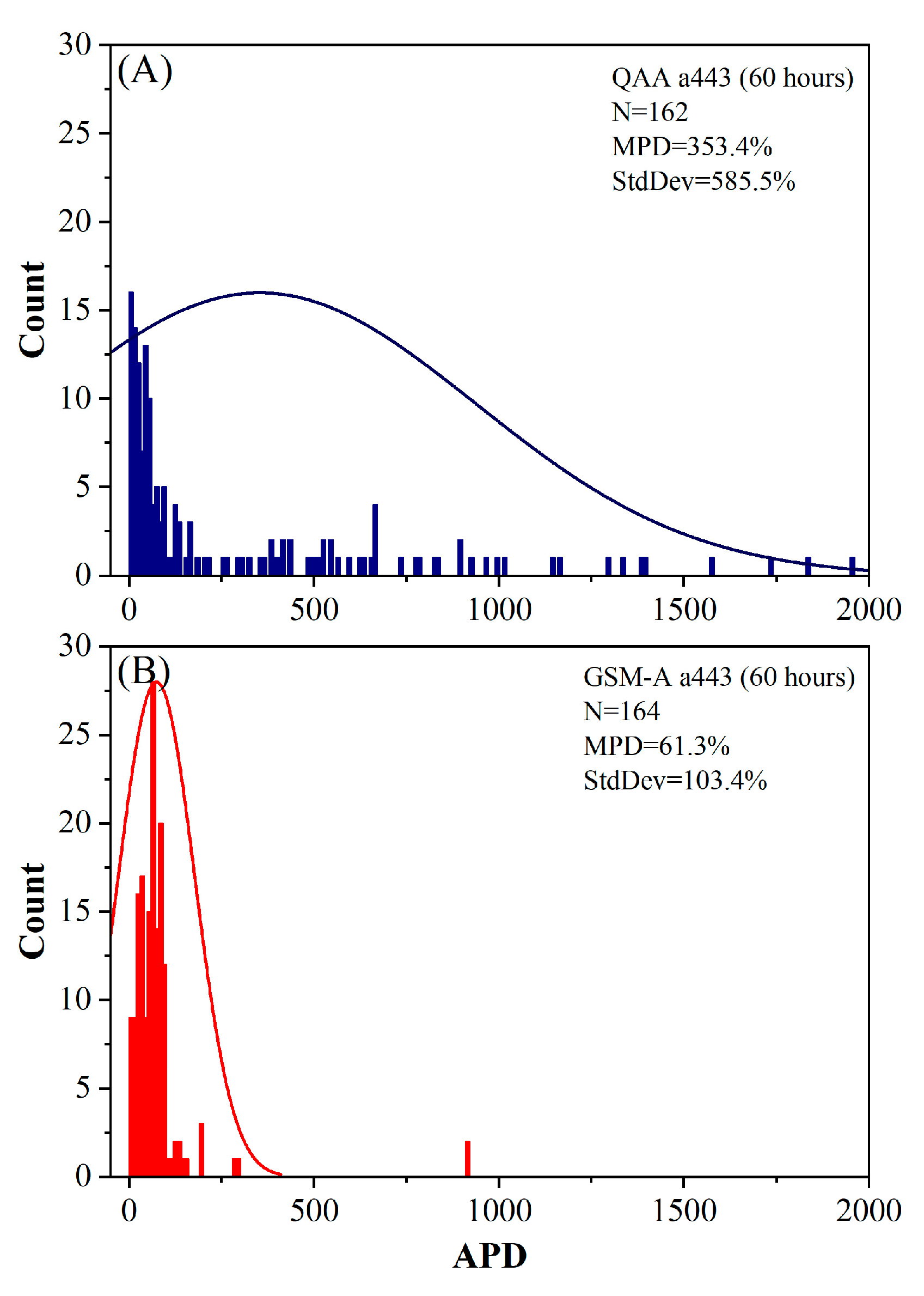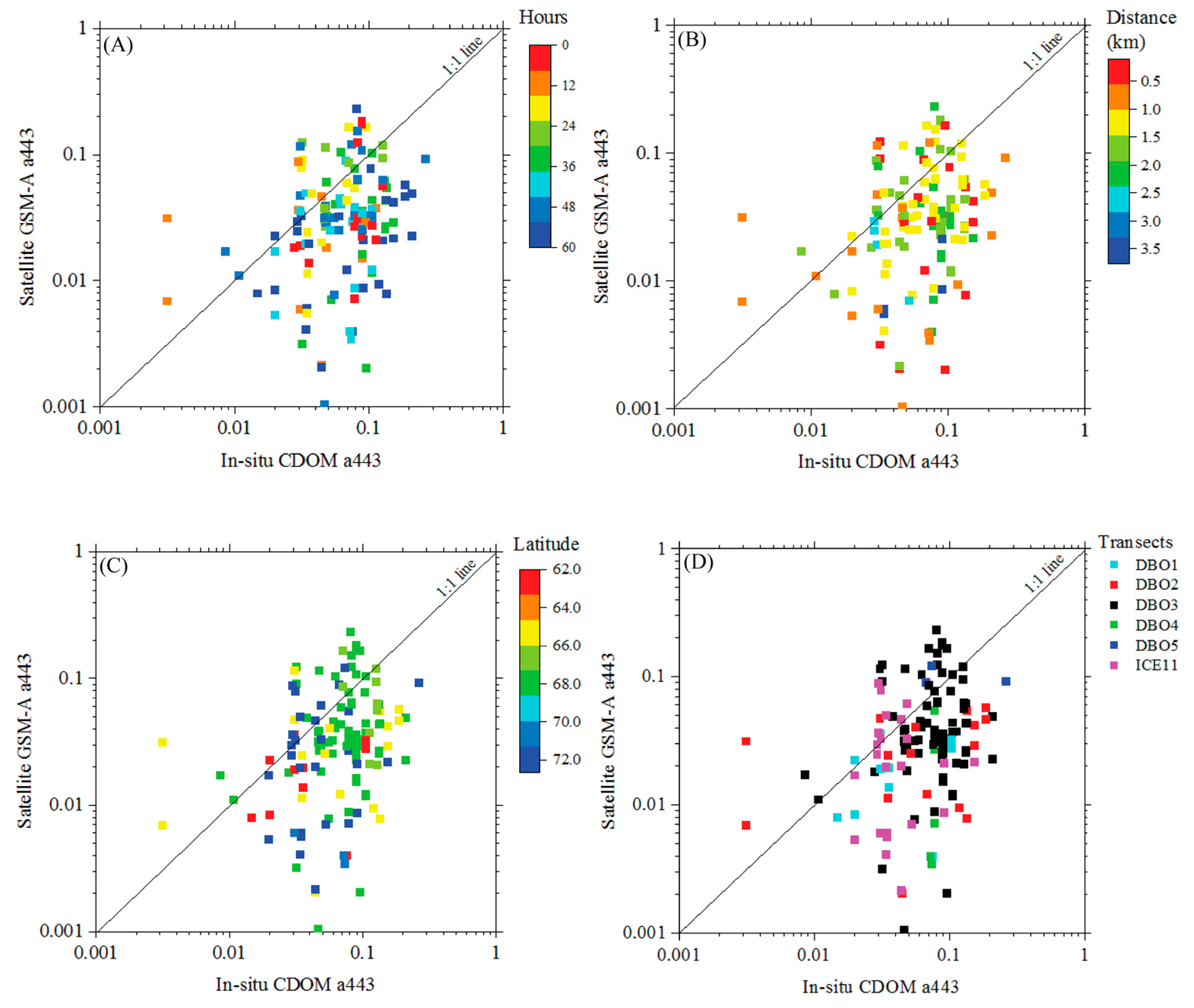Assessment of Empirical and Semi-Analytical Algorithms Using MODIS-Aqua for Representing In-Situ Chromophoric Dissolved Organic Matter (CDOM) in the Bering, Chukchi, and Western Beaufort Seas of the Pacific Arctic Region
Abstract
:1. Introduction
2. Materials and Methods
2.1. Study Area and CDOM Absorption
2.2. Ocean Color Satellite Remote Sensing Data
2.3. Statistical Analyses and Temporal Sensitivity Study
3. Results
3.1. R Values for Temporal Sensitivity Study
3.2. Statistically Significant CDOM Algorithms
4. Discussion
5. Conclusions
Author Contributions
Funding
Institutional Review Board Statement
Informed Consent Statement
Data Availability Statement
Acknowledgments
Conflicts of Interest
References
- Hill, V.J. Impacts of chromophoric dissolved organic material on surface ocean heating in the Chukchi Sea. J. Geophys. Res. 2008, 113, 1–10. [Google Scholar] [CrossRef]
- IPCC Special Report on the Ocean and Cryosphere in a Changing Climate; Pörter, H.O.; Roberts, D.C.; Masson-Delmotte, V.; Zhai, P.; Tignor, M.; Poloczanska, E.; Mintenbeck, K.; Alegría, A.; Nicolai, M.; Okem, A.; et al. (Eds.) Cambridge University Press: Cambridge, UK, 2019; p. 765. [Google Scholar]
- IPCC Summary for Policymakers. In Climate Change 2021: The Physical Science Basis. Contribution of Working Group I to the Sixth Assessment Report of the Intergovernmental Panel on Climate Change; Masson-Delmotte, V.; Zhai, P.; Pirani, A.; Connors, S.L.; Pean, C.; Berger, S.; Caud, N.; Chen, Y.; Goldfarb, L.; Gomis, M.I.; et al. (Eds.) Cambridge University Press: Cambridge, UK, 2021; p. 3949. [Google Scholar]
- Stroeve, J.; Holland, M.M.; Meier, W.; Scambos, T.; Serreze, M. Arctic sea ice decline: Faster than forecast. Geophys. Res. Lett. 2007, 34, 1–5. [Google Scholar] [CrossRef]
- Comiso, J.C.; Nishio, F. Trends in the sea ice cover using enhanced and compatible AMSR-E, SSM/I, and SMMR data. J. Geophys. Res. 2008, 113, 1–22. [Google Scholar] [CrossRef]
- Grebmeier, J.M.; Maslowski, W. The Pacific Arctic Region: An Introduction. In The Pacific Arctic Region: Ecosystem Status and Trends in a Rapidly Changing Environment; Grebmeier, J.M., Maslowski, W., Eds.; Springer: New York, NY, USA, 2014; pp. 1–16. [Google Scholar]
- Frey, K.E.; Moore, G.W.K.; Cooper, L.W.; Grebmeier, J.M. Divergent patterns of recent sea ice cover across the Bering, Chukchi, and Beaufort seas of the Pacific Arctic Region. Prog. Oceanogr. 2015, 136, 32–49. [Google Scholar] [CrossRef]
- Frey, K.E.; Perovich, D.K.; Light, B. The spatial distribution of solar radiation under a melting Arctic sea ice cover. Geophys. Res. Lett. 2011, 38, 1–6. [Google Scholar] [CrossRef] [Green Version]
- Arrigo, K.R.; Matrai, P.A.; van Dijken, G.L. Primary productivity in the Arctic Ocean: Impacts of complex optical properties and subsurface chlorophyll maxima on large-scale estimates. J. Geophys. Res. 2011, 116, 1–15. [Google Scholar] [CrossRef]
- Arrigo, K.R.; Perovich, D.K.; Pickart, R.S.; Brown, Z.W.; van Dijken, G.L.; Lowry, K.E.; Mills, M.M.; Palmer, M.A.; Balch, W.M.; Bahr, F.; et al. Massive phytoplankton blooms under Arctic sea ice. Science 2012, 336, 1408. [Google Scholar] [CrossRef] [Green Version]
- Kirk, J.T.O. Light and Photosynthesis in Aquatic Ecosystems, 3rd ed.; Cambridge University Press: Cambridge, UK, 2011. [Google Scholar]
- Logvinova, C.L.; Frey, K.E.; Cooper, L.W. The potential role of sea ice melt in the distribution of chromophoric dissolved organic matter in the Chukchi and Beaufort Seas. Deep Sea Res. Part II Top. Stud. Oceanogr. 2016, 130, 28–42. [Google Scholar] [CrossRef]
- Werdell, P.J.; Bailey, S.W. An improved in-situ bio-optical data set for ocean color algorithm development and satellite data product validation. Remote Sens. Environ. 2005, 98, 122–140. [Google Scholar] [CrossRef]
- Gupana, R.S.; Odermatt, D.; Cesana, I.; Giardino, C.; Nebdal, L.; Damm, A. Remote sensing of sun-induced chlorophyll-a fluorescence in inland and coastal waters: Current state and future prospects. Remote Sens. Environ. 2021, 262, 112482. [Google Scholar] [CrossRef]
- Morel, A.; Huot, Y.; Gentili, B.; Werdell, P.J.; Hooker, S.B.; Franz, B.A. Examining the consistency of products derived from various ocean color sensors in open ocean (Case 1) waters in the perspective of a multi-sensor approach. Remote Sens. Environ. 2007, 111, 6988. [Google Scholar] [CrossRef]
- Morel, A.; Gentili, B. A simple band ratio technique to quantify the colored dissolved and detrital organic material from ocean color remotely sensed data. Remote Sens. Environ. 2009, 113, 998–1011. [Google Scholar] [CrossRef]
- Maritorena, S.; Siegel, D.A.; Peterson, A.R. Optimization of a semianalytical ocean color model for global-scale applications. Appl. Opt. 2002, 41, 2705. [Google Scholar] [CrossRef] [PubMed]
- Lee, Z.; Carder, K.L.; Arnone, R.A. Deriving inherent optical properties from water color: A multiband quasi-analytical algorithm for optically deep waters. Appl. Opt. 2002, 41, 5755. [Google Scholar] [CrossRef] [PubMed]
- Lee, Z.; Weidemann, A.; Kindle, J.; Arnone, R.; Carder, K.L.; Davis, C. Euphotic zone depth: Its derivation and implication to ocean-color remote sensing. J. Geophys. Res. 2007, 112, 1–11. [Google Scholar] [CrossRef] [Green Version]
- Chaves, J.E.; Werdell, P.J.; Proctor, C.W.; Neeley, A.R.; Freeman, S.A.; Thomas, C.S.; Hooker, S.B. Assessment of ocean color data records from MODIS-Aqua in the western Arctic Ocean. Deep Sea Res. Part II Top. Stud. Oceanogr. 2015, 118, 32–43. [Google Scholar] [CrossRef]
- Lewis, K.M.; Mitchell, B.G.; van Dijken, G.L.; Arrigo, K.R. Regional chlorophyll a algorithms in the Arctic Ocean and their effect on satellite-derived primary production estimates. Deep Sea Res. Part II Top. Stud. Oceanography. 2016, 130, 14–27. [Google Scholar] [CrossRef]
- Martin, S. An Introduction to Ocean Remote Sensing, 2nd ed.; Cambridge University Press: Cambridge, UK, 2014. [Google Scholar]
- Carder, K.L.; Chen, F.R.; Lee, Z.P.; Hawes, S.K.; Kamykowski, D. Semianalytic Moderate-Resolution Imaging Spectrometer algorithms for chlorophyll a and absorption with bio-optical domains based on nitrate-depletion temperatures. J. Geophys. Res. 1999, 104, 5403–5421. [Google Scholar] [CrossRef]
- Maritonera, S.; Siegel, D. The GSM semi-analytical bio-optical model. In IOCCG (2006), Remote Sensing of Inherent Optical Properties: Fundamentals, Tests of Algorithms, and Applications; Lee, Z.P., Ed.; IOCCG: Victoria, BC, Canada, 2006; pp. 81–85. [Google Scholar]
- Matsuoka, A.; Hooker, S.B.; Bricaud, A.; Gentili, B.; Babin, M. Estimating absorption coefficients of colored dissolved organic matter (CDOM) using a semi-analytical algorithm for southern Beaufort Sea waters: Application to deriving concentrations of dissolved organic carbon from space. Biogeosciences 2013, 10, 917–927. [Google Scholar] [CrossRef] [Green Version]
- Matsuoka, A.; Babin, M.; Doxaran, D.; Hooker, S.B.; Mitchell, B.G.; Bélanger, S.; Bricaud, A. A synthesis of light absorption properties of the Arctic Ocean: Application to semianalytical estimates of dissolved organic carbon concentrations from space. Biogeosciences 2014, 11, 3131–3147. [Google Scholar] [CrossRef] [Green Version]
- Grebmeier, J.M.; Moore, S.E.; Cooper, L.W.; Frey, K.E. The Distributed Biological Observatory: A Change Detection Array in the Pacific Arctic. Deep Sea Res. Part II Top. Stud. Oceanogr. 2019, 162, 1–7. [Google Scholar] [CrossRef]
- Green, S.A.; Blough, N.V. Optical absorption and fluorescence properties of chromophoric dissolved organic matter in natural waters. Atlantic 1994, 39, 1903–1916. [Google Scholar] [CrossRef]
- Monger, B.; Meyer-Gutbrod, E.; Daly, M.; Wolfe, R. Cornell Satellite Remote Sensing Training Course Manual; Cornell University: Ithaca, NY, USA, 2016. [Google Scholar]
- Carder, K.L.; Chen, F.R.; Cannizzaro, J.P.; Campbell, J.W.; Mitchell, B.G. Performance of the MODIS semi-analytical ocean color algorithm for chlorophyll-a. Adv. Space Res. 2004, 33, 1152–1159. [Google Scholar] [CrossRef]
- Matsuoka, A.; Hill, V.; Huot, Y.; Babin, M.; Bricaud, A. Seasonal variability in the light absorption properties of western Arctic waters: Parameterization of the individual components of absorption for ocean color applications. J. Geophys. Res. 2011, 116, 1–15. [Google Scholar] [CrossRef] [Green Version]
- Kahru, M. Wim Automated Module (WAM) User’s Manual; Wimsoft: Scripps Institution of Oceanography UCSD: La Jolla, CA, USA, 2017. [Google Scholar]
- Willmont, C.J.; Matsuura, K. On the use of dimensioned measures of error to evaluate the performance of spatial interpolators. Int. J. Geogr. Inf. Sci. 2006, 20, 89–102. [Google Scholar] [CrossRef]
- Lawson, A.; Bowers, J.; Ladner, S.; Crout, R.; Wood, C.; Arnone, R.; Martinolich, P.; Lewis, D. Analyzing Satellite Ocean Color Match-Up Protocols Using the Satellite Validation Navy Tool (SAVANT) at MOBY and Two AERONET-OC Sites. Remote Sens. 2021, 13, 2673. [Google Scholar] [CrossRef]
- Griffin, C.G.; McClelland, J.W.; Frey, K.E.; Fiske, G.; Holmes, R.M. Quantifying CDOM and DOC in Major Arctic Rivers during Ice-Free Conditions using Landsat TM and ETM+ Data. Remote Sens. Environ. 2018, 209, 395–409. [Google Scholar] [CrossRef]
- Kutser, T.; Pierson, D.C.; Tranvik, L.; Reinart, A.; Sobek, S.; Kallio, K. Using Satellite Remote Sensing to Estimate the Colored Dissolved Organic Matter Absorption Coefficient in Lake. Ecosystems 2005, 8, 709–720. [Google Scholar] [CrossRef]
- Coelho, C.; Heim, B.; Foerster, S.; Brosinky, A.; De Araújo, J.C. In situ and Satellite Observation of CDOM and Chlorophyll-a Dynamics in Small Water Surface Reservoirs in the Brazilian Semiarid Region. Water 2017, 9, 913. [Google Scholar] [CrossRef] [Green Version]
- Li, J.; Yang, Y.; Wang, G.; Cheng, H.; Sun, L. Enhanced Oceanic Environmental Responses and Feedbacks to Super Typhoon Nida during the Sudden-Turning Stage. Remote Sens. 2021, 13, 2648. [Google Scholar] [CrossRef]





| Algorithm | Time (h) | N | R | MD | MAD | Slope |
|---|---|---|---|---|---|---|
| GSM a443 | ±36 | 50 | 0.36 | 0.12 | 0.13 | 2.39 |
| QAA a443 | ±36 | 70 | 0.44 | 0.16 | 0.17 | 2.87 |
| ±48 | 113 | 0.25 | 0.10 | 0.13 | 1.07 | |
| ±60 | 162 | 0.23 | 0.09 | 0.12 | 0.93 | |
| GSM-A a443 | ±48 | 122 | 0.30 | 0.02 | 0.04 | 0.29 |
| ±60 | 164 | 0.21 | −0.03 | 0.05 | 0.20 |
Publisher’s Note: MDPI stays neutral with regard to jurisdictional claims in published maps and institutional affiliations. |
© 2021 by the authors. Licensee MDPI, Basel, Switzerland. This article is an open access article distributed under the terms and conditions of the Creative Commons Attribution (CC BY) license (https://creativecommons.org/licenses/by/4.0/).
Share and Cite
Santiago, M.I.; Frey, K.E. Assessment of Empirical and Semi-Analytical Algorithms Using MODIS-Aqua for Representing In-Situ Chromophoric Dissolved Organic Matter (CDOM) in the Bering, Chukchi, and Western Beaufort Seas of the Pacific Arctic Region. Remote Sens. 2021, 13, 3673. https://doi.org/10.3390/rs13183673
Santiago MI, Frey KE. Assessment of Empirical and Semi-Analytical Algorithms Using MODIS-Aqua for Representing In-Situ Chromophoric Dissolved Organic Matter (CDOM) in the Bering, Chukchi, and Western Beaufort Seas of the Pacific Arctic Region. Remote Sensing. 2021; 13(18):3673. https://doi.org/10.3390/rs13183673
Chicago/Turabian StyleSantiago, Melishia I., and Karen E. Frey. 2021. "Assessment of Empirical and Semi-Analytical Algorithms Using MODIS-Aqua for Representing In-Situ Chromophoric Dissolved Organic Matter (CDOM) in the Bering, Chukchi, and Western Beaufort Seas of the Pacific Arctic Region" Remote Sensing 13, no. 18: 3673. https://doi.org/10.3390/rs13183673






